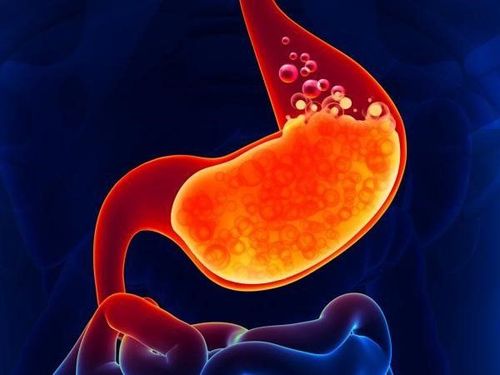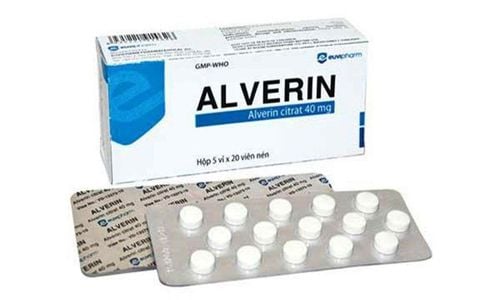This is an automatically translated article.
Pantonew is an injectable solution that belongs to the group of drugs that act on the respiratory tract, often indicated for the treatment of gastroesophageal reflux disease, ulcers in the gastrointestinal tract... Here are detailed information about its uses, How to use, dosage and notes and cautions when using this drug that patients need to know when it is indicated for use.
1. What is Pantonew?
Pantonew is a pharmaceutical company Central Pharmaceutical Joint Stock Company 1 (Pharbaco), Vietnam produces and is responsible for.
Pantonew belongs to the group of drugs acting on the respiratory tract with the main ingredient being Pantoprazol sodium equivalent to Pantoprazol 40mg/vial. The drug is prepared in the form of an injection solution and packaged in a box of 1 vial of powder for injection plus 1 ampoule of 10 ml of 0.9% sodium chloride injection solution. The drug is used in the treatment of gastroesophageal reflux disease (GERD), peptic ulcers...
2. Uses of Pantonew
2.1 What does Pantonew do? The drug is a specific and irreversible inhibitor of the proton pump, due to its selective action on the wall of gastric cells, which is faster and more effective than other drugs. The healing rate of peptic ulcers can be achieved 95% after 8 weeks of treatment.
The drug has little effect on gastric juice volume and pepsin secretion, as well as gastric endogenous factors and gastric contractility.
2.2. Indications for use of the drug Pantonew Pantonew is often indicated in the treatment of a number of diseases such as:
Gastroesophageal reflux disease. Gastrointestinal ulcers. Prevention of gastrointestinal ulcers caused by non-steroidal anti-inflammatory drugs. Zollinger-Ellison syndrome. 2.3. Contraindications Pantonew The drug is contraindicated in case of hypersensitivity to Pantoprazol wall or to any of the excipients contained in the drug, or other benzimidazole derivatives (such as lansoprazole, esomeprazole, rabeprazole, omeprazole). .
3. How to use and use Pantonew
Pantonew is a medicine that is only used when prescribed and prescribed by a qualified doctor. Therefore, the patient needs to take the drug exactly as prescribed, according to the instructions of the doctor and the manufacturer.
Dosage:
Depending on each treatment purpose, the progression of the disease and the patient's condition, the doctor will prescribe an appropriate and specific dose of the drug. The reference dose of that drug is:
Gastroesophageal reflux disease (GERD):
Usual dose: 20-40mg x 1 time / day for 4 weeks and can last up to 8 weeks. Maintenance dose: 20-40mg/day. Recurrence: 20mg/day. Gastrointestinal ulcers:
Usual dose: 40mg once daily for 2-4 weeks for duodenal ulcers or 4-8 weeks for benign gastric ulcers. Eradicate Helicobacter pylori: Use a combination therapy regimen of Pantoprazol 40mg x 2 times/day, in combination with Amoxicillin 1g x 2 times/day or Metronidazol 400mg x 2 times/day and Clarithromycin 500mg x 2 times/day. Prevention of peptic ulcers caused by non-steroidal anti-inflammatory drugs:
Use 20mg per day. Zollinger - Ellison syndrome:
Initial dose: Use 80mg/day, up to 240mg/day can be used, if the dose is over 80mg/day, it should be divided into 2 times. For patients with hepatic impairment, the maximum dose is 20mg/day or 40mg/day for alternate days, and for patients with renal impairment, the maximum dose is 40mg/day.
How to use:
Drink once a day in the morning, swallow whole, do not crush or chew.
4. Pantonew drug side effects
In general, pantoprazole is well tolerated with both short-term and long-term treatment. Proton pump inhibitors will reduce stomach acidity but may increase the risk of gastrointestinal infections.
Common side effects are: Fatigue, headache, urticaria, skin rash, joint pain, muscle pain. Uncommon side effects: Dizziness, lightheadedness, weakness, itching, increased liver enzymes. Rare: Peripheral edema, diaphoresis, malaise, anaphylaxis, acne vulgaris, maculopapular rash, exfoliative dermatitis, alopecia, angioedema, erythema multiforme, belching, gastrointestinal disturbances, inflammation mouth, photophobia, blurred vision, somnolence, insomnia, agitation or inhibition, tremor, tinnitus, hallucinations, confusion, paresthesia, agranulocytosis, thrombocytopenia, impotence, hematuria, interstitial nephritis, jaundice, hepatitis, elevated triglycerides, encephalopathy in liver failure, hyponatremia. Note: If you see the above side effects or other unusual side effects when taking the drug, it is necessary to notify the treating doctor for advice and timely handling measures.
5. Drug interactions
Drugs whose absorption depends on the pH of the stomach: Theoretically, when Pantoprazol is used concomitantly with drugs whose absorption depends on the pH of the stomach (eg iron salts, Ampicillin esters, Ketoconazole) It may decrease or increase the absorption of the drug by increasing the pH of the stomach. Drugs Acting on the Liver Enzyme System: Pantoprazole is extensively metabolised in the liver and mainly via the cytochrome P-450 (CYP) isoenzyme 2C19, and to a lesser extent through the isoenzymes CYP3A4, CYP2D6 and CYP2C9. However, clinical trials have shown no significant interactions between pantoprazole and other drugs metabolised via the same isoenzyme. Warfarin: Concomitant use of Warfarin with proton pump inhibitors, including pantoprazole, has the potential to increase INR and prothrombin time. An increase in INR and prothrombin time should be monitored when pantoprazole is co-administered with warfarin. Sucralfate: May delay absorption and decrease the effect of proton pump inhibitors (eg Lansoprazole, Omeprazole). Therefore, a proton pump inhibitor should be taken at least 30 minutes before taking Sucralfate. In order to avoid drug interactions that affect the effectiveness of the drugs being taken, the patient should list and inform the treating doctor about all the medicines he is taking, including medicine for disease or other foods. functional products.
6. Notes and cautions when using Pantonew
In order for the use of Pantonew to promote the best effect and the safest use, users also need to pay attention and be extra cautious with some of the following issues: specialist doctor. Do not arbitrarily use drugs or change the dosage, the way of use without the prescription of the doctor. Long-term use, especially in high doses, may slightly increase the risk of fractures of the wrist, spine, and hip. Therefore, patients at risk for osteoporosis should receive directed care and adequate calcium and vitamin D supplementation. Severe hypomagnesaemia has been reported in patients treated with pump inhibitors. protons for at least 3 to 1 year. Therefore, it is necessary to measure magnesium levels in patients requiring long-term therapy or taking proton pump inhibitors concurrently with digoxin or other hypomagnesaemic agents. The possibility of peptic ulcer malignancy should be excluded prior to administration of pantoprazole as it may mask the symptoms of peptic ulcer malignancy leading to delay in diagnosis. Hepatic Effects: A slight and transient increase in serum ALT (SGPT) has been reported with oral pantoprazole therapy. There are no adequate safety studies of pantoprazole in pregnant women. Therefore, women who are pregnant should not use it, unless absolutely necessary. The drug can pass into breast milk, so it is necessary to stop breastfeeding while taking the drug or stop taking the drug while breastfeeding to avoid affecting the health of the baby. The drug can cause dizziness and visual disturbances, so do not use it while driving or operating machinery.
7. Missed dose, overdose of Pantonew
Missed dose: Can take as soon as you remember within 1-2 hours of the prescribed time, but if it is almost time for the next dose, continue to take the next dose at the prescribed time without taking the dose. forgot. Do not take a double dose to make up for a missed dose to avoid increased side effects.
Overdose: If there are signs of suspected overdose during the use of the drug, it is necessary to notify the doctor for advice on how to safely handle it. In case of danger and emergency, it is necessary to take the patient to the nearest medical center for emergency and timely and effective treatment.
8. Preservation of drugs
Store the medicine in a dry place with a temperature not exceeding 30 degrees Celsius and should be protected from moisture and sunlight. Keep the medicine out of the reach of small children to prevent children from playing and taking the wrong medicine, which is dangerous to health.
For disposing of medicines when they are no longer in use, or their packaging, it is advisable to consult your doctor or local waste disposal company for advice on how to safely dispose of them. Do not throw it into the toilet or flush it under the household's daily faucet.
Above is all information about the uses, indications, usage, dosage and notes and cautions when using Pantonew that patients need to understand. This is a prescription drug, so the patient should not arbitrarily use it under any circumstances.













